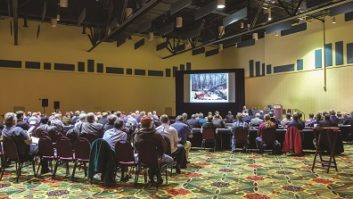
If you’re a tech manager in a bureaucracy, you’ll appreciate the headaches that confront engineers at the International Broadcasting Bureau.
Lack of standards, poor IT wiring, vulnerable points-of-failure, an inundation of new platforms and low morale might plague any organization. But we get an unusually frank look at such problems within the technical arm of U.S. international broadcasting thanks to an in-house report that came to light recently.
It was written in 2010 by the new top engineer at the IBB, which supports the Broadcasting Board of Governors. That in turn runs Voice of America, Radio Free Europe/Radio Liberty, Radio Free Asia, the Middle East Broadcasting Networks and the Office of Cuba Broadcasting.
André V. Mendes set out a plan of how to “transform” their technical and IT operations. As I wrote on Radio World’s website, the attention-grabber is a recommendation to lay out a plan to “sunset” U.S. shortwave operations; but there’s lots of interesting reading in the “2010–2012 BBG Technology Strategic Plan.” A Freedom of Information Act request led to its publication on nonprofit governmentattic.org.
‘Serious impediment’
Intriguing is how he paints issues within IBB’s two technology spheres — traditional engineering and IT — and how those overlap, not always smoothly.
“Today’s effective separation and isolation between engineering and IT constitutes a serious impediment to progress,” Mendes wrote.
He laid out problems facing engineering staff, noting the proliferation of platforms they must learn — AM, FM, satellite radio, satellite TV, Internet and telephone-based content distribution — without cuts elsewhere (sound familiar?). He called it a “silent but ever-growing burden of a burgeoning distribution methodologies portfolio.”

He talks about the complexity of systems engineers must administer; declining financial resources; a disorganized, incoherent Network Control Center; and lack of a solid business continuity/disaster plan.
Poignantly, he described a shift in job skill relevance among engineers as BBG’s dependence on shortwave shifts to third-party operations, satellite and other platforms. “This issue is further compounded by the relatively difficult transition from a traditional RF, antenna, transmitter design and maintenance knowledge base to the technologies involved in digital satellite and IP-based networking systems.”
He also identified a problem of low morale among engineers, calling the mood “palpable.”
Meantime, while the IT side “manages to deliver a relatively high level of service,” he identified multiple single points of failure in critical IT infrastructure; poor layout and maintenance; “nonexistent” business continuity and disaster recovery plans; and other issues.
He wrote that the organization’s network was dependent on a single enterprise-class Cisco core router whose failure would “severely cripple the entire agency” for an extended period. He provided photos as evidence that “the cabling infrastructure that supports the BBG network is in serious disarray,” criticized past decisions regarding the agency’s e-mail platform and spoke of “blurry lines of responsibility, finger pointing, morale issues and lower overall performance” in IT.
Overall, and without accusing individuals, he wrote that various circumstances had created an “organizational insularity” at IBB that called for a rejuvenation.
Playing catchup
On a broad level, he recommended that the organization consolidate platforms.
“In the engineering arena, this approach will be mostly focused on the usage of shortwave and the pragmatic analysis of its expected lifespan and overall scope of global operations but also will include continued migration to MPEG-4 compression technology and steady introduction of IP transmission protocols. In the IT arena, this process will endeavor to quickly reduce the number of computing and storage platforms.”
He recommended use of server, storage and networking virtualization. He said BBG should colocate systems into data centers with multiple redundancy layers, and eventually migrate much of its application portfolio into cloud computing; he pointed out that BBG is already using the cloud in some applications.
He also laid out operational recommendations, starting in the first year with changing the name of the Office of Engineering and Technical Services (to Technology, Services and Innovation); setting up a new tech management structure; creating an application and database to manage transmission and content distribution assets; and creating a Security, Business Continuity and Disaster Recovery Office.
He called for continued migration to MPEG-4 content encoding; an upgrade of the Network Control Center; outsourcing of station operations in Bangkok and Udorn in Thailand; and applying what they learn from that outsourcing to other shortwave operations. He recommended a big IT consolidation effort; fixing IT wiring; eliminating single points of failure; implementing a hosted e-mail, IM, conferencing and Blackberry server system; and expanding the use of internal intranet sites.
It’s not clear how many of his goals, if adopted, were accomplished in the last 12 months. He also laid out broader goals for the second year.
Slow sunset
I never met André V. Mendes; indeed I learned while writing my online article that he is a former contributor to Radio World’s sister publication TV Technology. But based on my limited exposure to the subject, his report seems an intelligent discussion of real problems.
I can imagine he upset some apple carts. Who wants photos of their bad wiring spread around the Internet? And whether Mendes and the staff have the chops to change an entrenched technology culture embedded within a federal bureaucracy is hard to predict.
As far as shortwave, Mendes did recommend that the organization create a strategy to “sunset” SW operations.
I think the term “sunset” is misleading because it suggests a finality that the report doesn’t recommend. Mendes told me in a subsequent e-mail that shortwave “will remain an important medium for the BBG where it is a viable one, but its use will be driven by audience habits and the relative costs of transmission.”
However, it’s noteworthy that a top technical executive is using that language, and it shows the direction BBG management is likely to continue.
Expect more reductions of BBG-owned SW facilities; more outsourcing; more sharing of resources with other broadcasters; and/or more leasing of capacity from third parties. If you’re interested in the fate of U.S. shortwave, all the more reason to read his report, which concluded among other things that “the decision process for station closing does not appear to follow an overt decision and stated plan to reduce shortwave usage.”
You can read it in PDF format; visit governmentattic.org, key phrase BBG Technology. Note that it is followed by separate earlier information about the organization’s technology and new media efforts.











